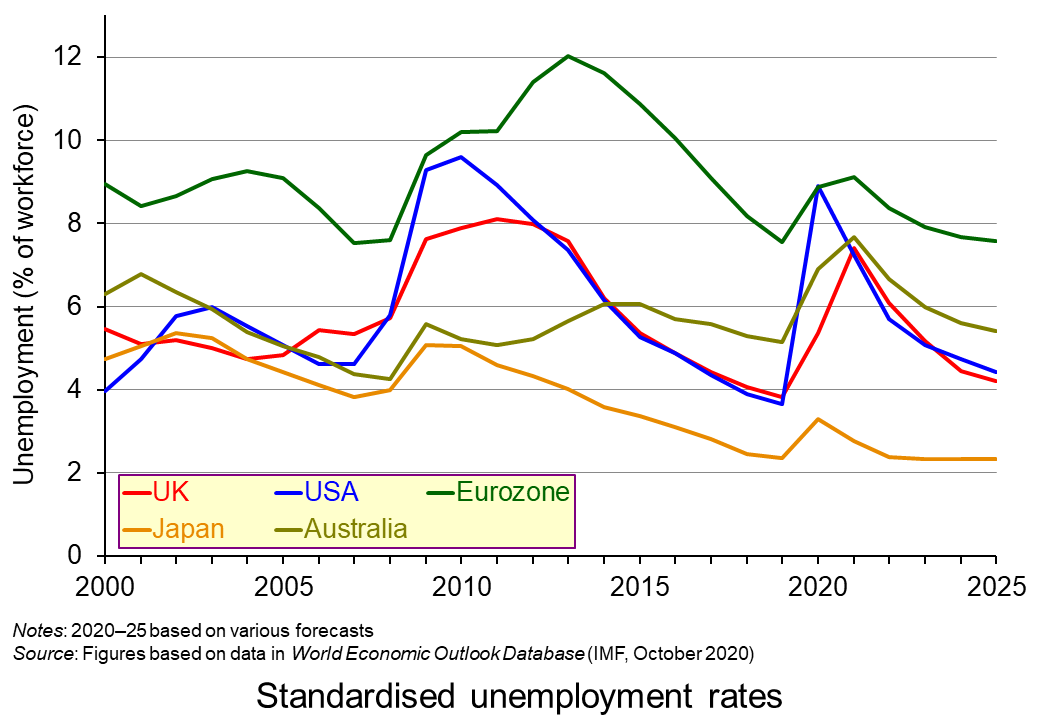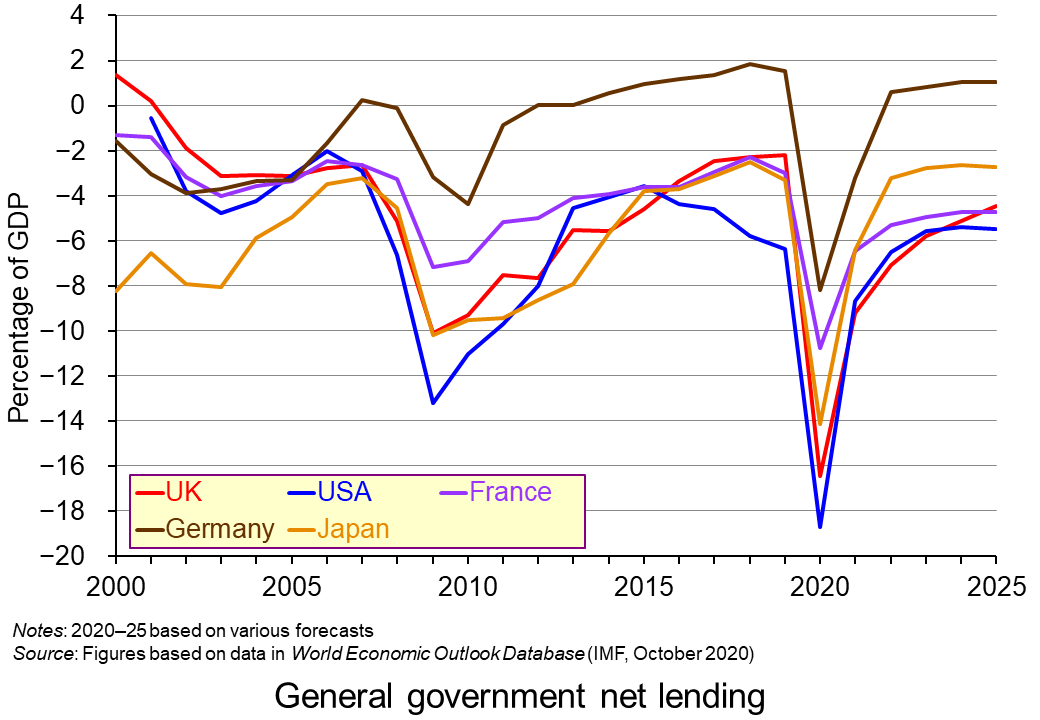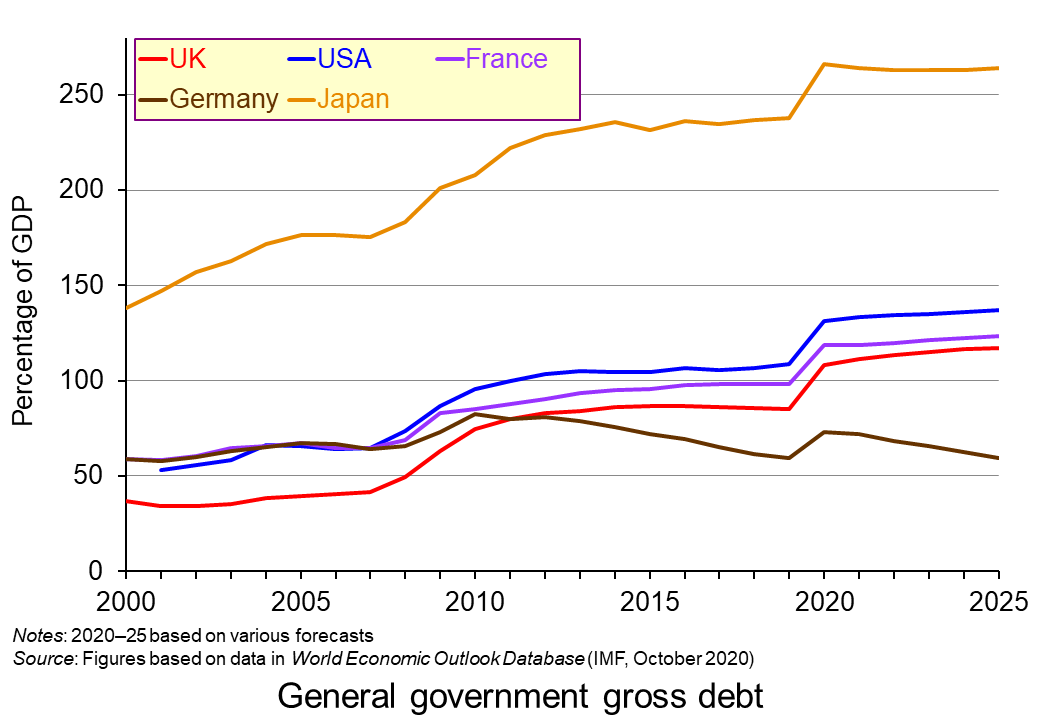The macroeconomic outlook over the next few years: a Covid hangover
 Back in June, we examined the macroeconomic forecasts of the three agencies, the IMF, the OECD and the European Commission, all of which publish forecasts every six months. The IMF has recently published its latest World Economic Outlook (WEO) and its accompanying database. Unlike the April WEO, which, given the huge uncertainty surrounding the pandemic and its economic effects, only forecast as far as 2021, the latest version forecasts as far ahead as 2025.
Back in June, we examined the macroeconomic forecasts of the three agencies, the IMF, the OECD and the European Commission, all of which publish forecasts every six months. The IMF has recently published its latest World Economic Outlook (WEO) and its accompanying database. Unlike the April WEO, which, given the huge uncertainty surrounding the pandemic and its economic effects, only forecast as far as 2021, the latest version forecasts as far ahead as 2025.
 In essence the picture is similar to that painted in April. The IMF predicts a large-scale fall in GDP and rise in unemployment, government borrowing and government debt for 2020 (compared with 2019) across virtually all countries.
In essence the picture is similar to that painted in April. The IMF predicts a large-scale fall in GDP and rise in unemployment, government borrowing and government debt for 2020 (compared with 2019) across virtually all countries.
World real GDP is predicted to fall by 4.4%. For many countries the fall will be much steeper. In the UK, GDP is predicted to fall by 9.8%; in the eurozone, by 8.3%; in India, by 10.3%; in Italy, by 10.8%; in Spain, by 12.8%.  There will then be somewhat of a ‘bounce back’ in GDP in 2021, but not to the levels of 2019. World real GDP is predicted to rise by 5.2% in 2021. (Click here for a PowerPoint of the growth chart.)
There will then be somewhat of a ‘bounce back’ in GDP in 2021, but not to the levels of 2019. World real GDP is predicted to rise by 5.2% in 2021. (Click here for a PowerPoint of the growth chart.)
Unemployment will peak in some countries in 2020 and in others in 2021 depending on the speed of recovery from recession and the mobility of labour. (Click here for a PowerPoint of the unemployment chart.)
 Inflation is set to fall from already low levels. Several countries are expected to see falling prices.
Inflation is set to fall from already low levels. Several countries are expected to see falling prices.
Government deficits (negative net lending) will be sharply higher in 2020 as a result of government measures to support workers and firms affected by lockdowns and falling demand. Governments will also receive reduced tax revenues. (Click here for a PowerPoint of the general government net lending chart.)
 Government debt will consequently rise more rapidly. Deficits are predicted to fall in 2021 as economies recover and hence the rise in debt will slow down or in some cases, such as Germany, even fall. (Click here for a PowerPoint of the general government gross debt chart.)
Government debt will consequently rise more rapidly. Deficits are predicted to fall in 2021 as economies recover and hence the rise in debt will slow down or in some cases, such as Germany, even fall. (Click here for a PowerPoint of the general government gross debt chart.)
After the rebound in 2021, global growth is then expected to slow to around 3.5% by 2025. This compares with an average of 3.8% from 2000 to 2019. Growth of advanced economies is expected to slow to 1.7%. It averaged 1.9% from 2000 to 2019. For emerging market and developing countries it is expected to slow to 4.7% from an average of 5.7% from 2000 to 2019. These figures suggest some longer-term scarring effects from the pandemic.
Uncertainties
 In the short term, the greatest uncertainty concerns the extent of the second wave, the measures put in place to contain the spread of the virus and the compensation provided by governments to businesses and workers. The WEO report was prepared when the second wave was only just beginning. It could well be that countries will experience a deeper recession in 2000 and into 2021 than predicted by the IMF.
In the short term, the greatest uncertainty concerns the extent of the second wave, the measures put in place to contain the spread of the virus and the compensation provided by governments to businesses and workers. The WEO report was prepared when the second wave was only just beginning. It could well be that countries will experience a deeper recession in 2000 and into 2021 than predicted by the IMF.
This is recognised in the forecast.
The persistence of the shock remains uncertain and relates to factors inherently difficult to predict, including the path of the pandemic, the adjustment costs it imposes on the economy, the effectiveness of the economic policy response, and the evolution of financial sentiment.
With some businesses forced to close, others operating at reduced capacity because of social distancing in the workplace and with dampened demand, many countries may find output falling again. The extent will to a large extent depend on the levels of government support.
In the medium term, it is assumed that there will be a vaccine and that economies can begin functioning normally again. However, the report does recognise the long-term scarring effects caused by low levels of investment, deskilling and demotivation of the parts of the workforce, loss of capacity and disruptions to various supply chains.
The deep downturn this year will damage supply potential to varying degrees across economies. The impact will depend on various factors … including the extent of firm closures, exit of discouraged workers from the labour force, and resource mismatches (sectoral, occupational and geographic).
 One of the greatest uncertainties in the medium term concerns the stance of fiscal and monetary policies. Will governments continue to run large deficits to support demand or will they attempt to reduce deficits by raising taxes and/or reducing benefits and/or cutting government current or capital expenditure?
One of the greatest uncertainties in the medium term concerns the stance of fiscal and monetary policies. Will governments continue to run large deficits to support demand or will they attempt to reduce deficits by raising taxes and/or reducing benefits and/or cutting government current or capital expenditure?
Will central banks continue with large-scale quantitative easing and ultra-low or even negative interest rates? Will they use novel forms of monetary policy, such as directly funding government deficits with new money or providing money directly to citizens through a ‘helicopter’ scheme (see the 2016 blog, New UK monetary policy measures – somewhat short of the kitchen sink)?
Forecasting at the current time is fraught with uncertainty. However, reports such as the WEO are useful in identifying the various factors influencing the economy and how seriously they may impact on variables such as growth, unemployment and government deficits.
Report, speeches and data
- World Economic Outlook, October 2020: A Long and Difficult Ascent
- World Economic Outlook Databases
- “We Must Take the Right Actions Now!”—Opening Remarks for Annual Meetings Press Conference
 Press Briefing: World Economic Outlook
Press Briefing: World Economic Outlook
IMF, Report (October 2020)
IMF (October 2020)
IMF, Speech, Kristalina Georgieva, IMF Managing Director (14/10/20)
IMF, Gita Gopinath, Chief Economist and Director of the Research Department, IMF; Gian Maria Milesi-Ferretti, Deputy Director, Research Department, IMF; Malhar Shyam Nabar, Division Chief, Research Department, IMF; Moderator: Raphael Anspach, Senior Communications officer, Communications Department, IMF (13/10/20)
Articles
- IMF upgrades 2020 economic forecast but warns of a slower 2021
- IMF hints at improved global GDP forecast but warns of ‘difficult climb’ ahead
- IMF estimates global Covid cost at $28tn in lost output
- IMF and World Bank must act fast after Covid caught policymakers napping
- IMF Sees Shallower Recession, Tough Path Back to Recovery
BBC News, Andrew walker (13/10/20)
Business Insider, Ben Winck (6/10/20)
The Guardian, Larry Elliott (13/10/20)
The Guardian, Larry Elliott (11/10/20)
Bloomberg, Eric Martin (13/10/20)
Questions
- Explain what is meant by ‘scarring effects’. Identify various ways in which the pandemic is likely to affect aggregate supply over the longer term.
- Consider the arguments for and against governments continuing to run large budget deficits over the next few years.
- What are the arguments for and against using ‘helicopter money’ in the current circumstances?
- On purely economic grounds, what are the arguments for imposing much stricter lockdowns when Covid-19 rates are rising rapidly?
- Chose two countries other than the UK, one industrialised and one developing. Consider what policies they are pursuing to achieve an optimal balance between limiting the spread of the virus and protecting the economy.